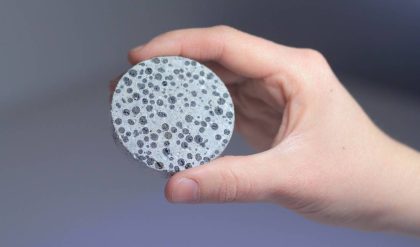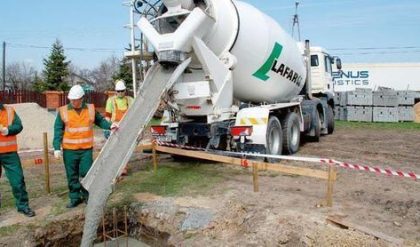Pozzolans
Other materials may be blended with Portland cement to meet special requirements and environmental considerations. Some of these materials, called pozzolans, do not have cementicious properties until mixed with Portland cement. When concrete is mixed, in order to improve its workability and flow characteristics, more water is added beyond what is needed for hydration. This surplus water is then present in tiny capillary channels in the hydrated (hardened) concrete. When a pozzolan material is substituted for a portion of the cement, a secondary chemical reaction takes place after hydration. Chemicals released from the cement paste during hydration react with chemicals in the pozzolan material to form a material that partially or fully fills these capillary channels. This makes concrete more dense and increases its resistance to chemicals (such as those used for de-icing operations) that can penetrate porous concrete and corrode reinforcement steel and cause surface deterioration or spalling.

Surface spalling caused by de-icing chemicals
When a portion of the cement is replaced with pozzolans, less heat is produced during hydration. This secondary reaction produces some heat, but the peak temperatures are lower and spread out over a longer period of time. Since concrete contracts (shrinks) as it cools, less heat means less overall shrinkage. Since shrinkage creates stresses that are relieved by cracking, less shrinkage means fewer cracks. This is especially important with high-mass structures that cannot release heat easily, such as dams.
Fly Ash

Flay ash viewed at the microscopic level
Fly ash is an industrial by-product that is sometimes used as a partial replacement for Portland cement. Fly ash is composed of the non-combustible particulates that are removed from the flue gas of coal-burning power plants. It may form up to 65% of the mass of cementicious materials, depending on the performance requirements of the concrete and the type of coal burned.
Reclaiming fly ash for industrial use is an environmentally sound practice, since fly ash is removed from flue gas to improve air quality, and its use in cement means that what was once a waste product is now recycled as a useful material. As of 2005, U.S. coal-fired power plants reported producing 71 million tons of fly ash, 29 million tons of which were used in various applications. The remaining 42 million tons could cover an acre of land to a depth of 27,500 feet. This unused fly ash takes up space in landfills and contains toxins that can contaminate aquifers. In December 2008, an embankment at a Tennessee Valley Authority fly ash storage facility in Kingston, Tennessee, failed and released 5.4 million cubic yards of fly ash into the Emory River. Cleanup costs are approaching $1.2 billion.

Failure of a fly ash containment facility in Kingston, Tennessee
Here are some relevant facts about fly ash used in concrete:
· Fly ash comes in types F and C. Type F fly ash is made by burning older, harder coal. It is a pozzolan and when mixed with water, does not produce cementicious compounds unless the mix includes Portland cement. Type C is made by burning younger, softer coal and does have some cementicious compounds when it’s mixed with water.
· Very fine particles of fly ash can improve the flow characteristics of concrete, reduce costs by replacing cement, require less water in the mix, and make concrete more dense. Coarse particles do not provide the same benefits, and coarse and fine particles cannot always be separated effectively.
· It may increase the setting time.
· Fly ash does not accept pigments or acid stains as well as cement, so matching existing concrete made without fly ash can be a problem.
· The performance characteristics of fly ash vary with particulate size, but also with the chemical composition of the coal, the degree to which the coal is pulverized before burning, the combustion conditions in the furnace, and fly ash collection and handling methods. Since these factors are never the same in different power plants, and may even change within one power plant over time, the properties of fly ash can vary widely, and this can be a barrier to getting consistently good results.
· Fly ash has a specific surface of 1,400 to 3,400 ft2/lb (280 to 700 m2/kg), depending on type.



Comments are closed.